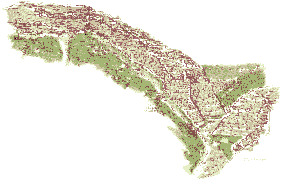 |
Sandal Motte
Tuesday, 15th October 2002, West Yorkshire |
![]()
![]()
![]()
![]() Rocks |
History |
Workshop |
Links |
Home Page
Rocks |
History |
Workshop |
Links |
Home Page
![]()
 'Stand in the centre of Wakefield,' wrote Lawrence Butler*, 'and, where you have a clear view, look southwards. There on the horizon is an upturned pudding-basin-shaped mound of earth and two jagged tusks of masonry. That is Sandal Castle. For nearly nine centuries its mound has dominated the southern horizon.'
'Stand in the centre of Wakefield,' wrote Lawrence Butler*, 'and, where you have a clear view, look southwards. There on the horizon is an upturned pudding-basin-shaped mound of earth and two jagged tusks of masonry. That is Sandal Castle. For nearly nine centuries its mound has dominated the southern horizon.'On this dull afternoon, seen from the rooftop car park of the Ridings Centre, it looks suitably grim against the ragged cloud of a rainswept sky. If we could go back 500 years you would see a structure about the size of the Ridings centre perched on top of those massive earthworks. The recently opened visitor centre at the castle and the access via bridge and steps to the motte are proving popular, both with school parties and the public.
As I wrote in my booklet on the castle;

It has been estimated that it took a team of 100 men two years to complete the earthworks at Sandal. The motte and bailey were constructed, probably soon after 1106, on a natural ridge of sandstone, the Oaks Rock. Soil and rocky debris from the moat were piled up in layers to form the motte. This stood 33 feet (10m) above the original ground level with the moat a further 23 feet (7m) deep around it. The motte was 130 feet (37m) in diameter, 48 feet (15m) at the summit.
Sandal Castle Books
Sandal Castle Wakefield, the History and Archaeology of a Medieval Castle by Lawrence Butler (1991) (Wakefield Historical Publications, 1991), ISBN 0-9011869-31-7.Sandal Castle by Richard Bell (Willow Island Editions, 2001) £2.95, ISBN 1-902467-05-1.
![]()
Richard Bell,
wildlife illustrator
E-mail; 'richard@willowisland.co.uk'
![]() Next page |
Previous page |
This day last year |
This month |
Nature Diary |
Home Page
Next page |
Previous page |
This day last year |
This month |
Nature Diary |
Home Page
![]()